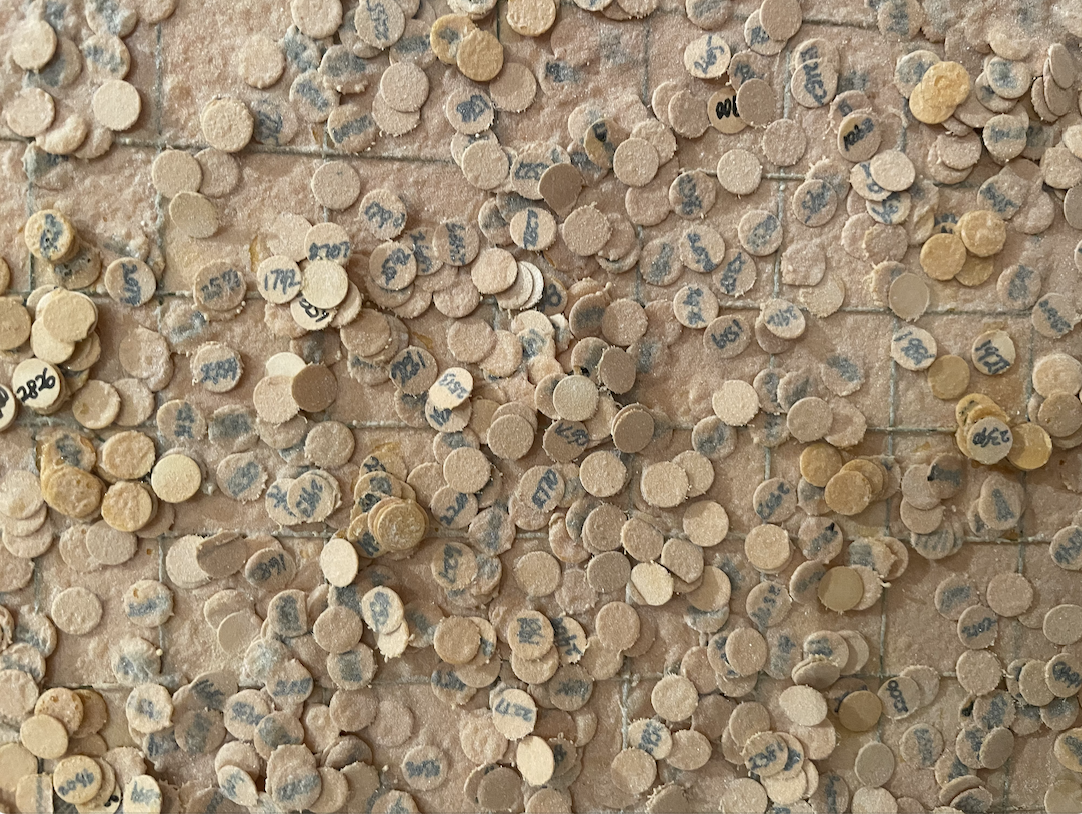“I’ve never had an experience like that… I’m free, white and 21”
Howardena Pindell seeks a new language, a language of abstraction and without ambiguity. Fruitmarket Gallery hosts Pindell’s first solo exhibition in the UK, showcasing Pindell’s abstract works and more visceral, figurative pieces. This retrospective allows reflection of the artist’s personal struggle from the 1980s to now, how their visual language has constantly evolved since the 1970s, to empower and fight against disenfranchisement, and ‘articulate empowerment’.
“You really must be paranoid”
Born in Philadelphia in 1943, only by the time she was 21 was the Civil Rights Act passed. Pindell studied her BFA at Boston University, giving her an intensely figurative background, followed by postgraduate studies at Yale 95’. In 1979 Pindell was in a serious car accident, in which she was lucky to survive with a concussion and partial memory loss. This traumatic event became a turning point in her career, from this point she began explicitly embedding text and literal language within her work, employing the direct activism she is now known for.
As you enter the Fruitmarket, pass through the cafe and bookshop, the ground floor is full of abstract compositions, drawings, and delicately textured paintings. There is an overwhelming intimate nature to her work, these ornate canvases and works are the product, method and transaction of perforated paper, where scraps have become stencils and punched dots repurposed, numbered and applied at random. They work in a sort of reverse pointillist impressionism, the closer you get the more of the picture you see.
Towards the back of this room is a blackout cinema space, where Free, White and 21 is on a constant loop.
Free, White and 21, is Pindell’s seminal work, made in 1980 only eight months after her car accident, she monologues to a camera, a deadpan, factual and raw account of her personal coming of age story as a black female artist in America reflecting on generational racism experienced and shared by her and her family, as well as her experiences in artistic institutions and from peers.
“You really must be paranoid”
Reflecting on the piece In her own words “I was bristling at the women’s movement as well as the art world and some of the usual offensive encounters that were heaped on top of the racism of my profession”. In this film she plays two characters, herself and a woman in whiteface, to embody the face of ‘free white and 21’, who serves to invalidate Pindell in real-time. Pindell speaks directly into the camera at the audience, the only physical performative action that occurs breaking eye contact, is Pindell applying white medical bandages around her head, and subsequently removing a white film from her face – as if to allude to cosmetic products marketed to women to lighten their skin, further to allude to themes of race, equality and levels of ‘blackness’ emphasised in her other works on display.
“You must use our symbols to be valid”
As the film draws to an end the work on the ground floor appears disjointed, a harrowing film addressing the audience is juxtaposed by seemingly apolitical works. But the displays continue upstairs.
Separate but Equal Genocide, 1991-92 and Columbus, grabbed my attention in the upstairs gallery. Columbus, addresses the legacy of the colonialist ventures, the large canvas is painted black and upon closer inspection, subtly overlaid handmarks emerge as words. What was most striking about this work for me was the intrusion onto the space, below the canvas are casts of severed hands, painted black, as if oozing out of history, directly speaking to words on the canvas: ‘ancient Egyptians cut off one hand of the enemy soldiers to count the enemy’s war dead’, Columbus is powerful, it directly addresses the legacy and trauma of racism and genocide of indigenous Americans.
Separate but equal addresses the personal and interpersonal dimensions of racialised and biased healthcare in the light of the AIDS pandemic. Two canvases resembling the compositions of American flags are on the wall, turned on their sides. These canvases are made with the same stitching and texturized composition as Pindell’s work downstairs, yet these works have text – names where stars and stripes would be. This immensely critical piece confronts the intimate nature of Pindell’s abstract practice with language and activism.
“I’ve never had an experience like that… I’m free, white and 21”
The upstairs gallery has numerous works that could captivate viewers for hours. These include her video drawings, as well as documentary video slides of Pindell speaking directly about her works, her relationship to abstraction, the women’s rights movement, and her own grappling of exclusion in the art world. In her own words, she asserts “I am an artist. I am not part of a so-called “minority”, or “new” or “emerging” or “a new audience”. These are terms used to demean, limit and make people of colour appear to be powerless. We must evolve a new language which empowers us and does not cause us to participate in our own disenfranchisement”. Fruitmarket achieves a celebratory exhibition through a significant selection of Pindell’s work to communicate her vision and artistic language powerfully.
This is a must-see exhibition.
Quotes from Free, White and 21, Howardena Pindell, 1980 12 minutes, 15 seconds, U-matic.
Photograph of Howardena Pindell’s work shown at Fruitmarket by Ash Tomkins

